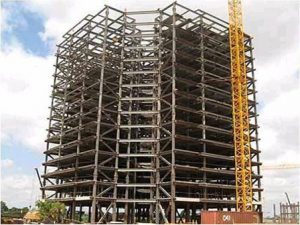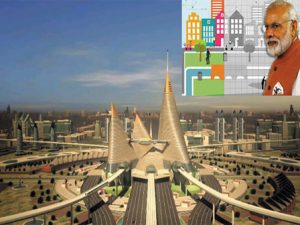Housing and Smart Cities: Why a ‘Steel Transition’ is Required?
Buildings account for around half the total carbon dioxide (CO2) emissions in most of the cities across the globe. Since cement is considered as one of the world's top industrial emitters of CO2, it is high-time to promote steel structure constructions to support low-carbon building stocks thereby saving the planet from an environmental disaster.

Globally, another 2.5 billion people are expected to live in urban areas by 2050, and 90 per cent of this increase will take place in Asia and Africa. This will intensify the pressure for creating adequate city infrastructure and billions of homes to be constructed to cater to the new urban residents. The “2019 Global Status Report for Buildings and Construction: Towards a zero-emission, efficient and resilient buildings and construction sector” says that 2020 is a key year for countries to enhance their Nationally Determined Contributions (NDCs), especially concerning further actions to address energy use and emissions including embodied emissions in the buildings and construction sector. According to the UN Global Alliance for Buildings and Construction, energy demand in this sector could increase by 50 per cent by 2060. Inger Andersen, Executive Director, UN Environment Programme, has said “The buildings and construction sector needs to meet this challenge by providing affordable, quality, comfortable, healthy and super-efficient homes and workplaces”. In the context of India, increase in the pace of urban population growth and the fundamental realities of the need for creating more houses, various commercial and other public buildings, are putting considerable pressure on the urban environment, which needs to be addressed on a priority basis.
Also Read : Steel Structure Housing A New Roadmap For Indias Housing For All
Advantages of Steel Structure
A comparative study by the Institute for Sustainability and Innovation in Structural Engineering, University of Coimbra, Portugal, showed that using Light Steel Frame (LSF) has several advantages compared to using the Reinforced Concrete (RC) in constructing residential buildings. It provides unbiased information about the advantages of steel for the construction sector, especially for the residential housing domain. The Institute identified strong and weak aspects of various structural solutions employing different materials, but the key advantageous it cited in using or switching over to steel structure-based residential buildings are significant for highly populated cities as those in India. Although steel and concrete are fundamental materials in the construction sector, the argument put forth is to give primacy on steel as against concrete structures. By comparing the established scenarios, where concrete is the norm, the study has observed that the RC structural solution is the heaviest one. Accordingly, the overall structural weight of the RC building was about 120 per cent higher than the cold-formed steel, 72 per cent higher than the hot-rolled steel building.
The steel building has much lower weight per unit area which impacts directly on the foundation as lower loads are transmitted.
The LSF structure is 55 per cent lighter than an RC equivalent, requiring less material. This difference is even more pronounced when constructing in areas with high seismic activity. Moreover, the percentage weight increase when accounting for potential earthquake activity in the design of a residential building is higher in the RC solution, which is due to higher mass, greater rigidity and less capacity for energy absorption in RC.

LSF is lighter, and only less concrete is required for the foundation. It thus requires 60 per cent less concrete, less water, less sand, as well as less cement and aggregate. LSF solution produces less CO2, which is 10 per cent less than RC, while considering all life cycle emissions from extraction through to manufacture and construction. For fire and acoustic compliance, specialist gypsum boards and other solutions including sprayed plaster, while intumescent paints that activate when heated, can be used to achieve fire protection on structural steel. Moreover, high performance acoustic insulation and gypsum boards provide high comfort for occupants. Environmental aspects include steel’s 100 per cent recyclability, as well as its re-usability and adaptability. LSF reduces demand for on-site resources and generates less waste.
Apart from what the University of Coimbra’s study has found, there are many significant advantages of using steel structure in construction. Steel is an economic construction material. Continuous R & D in steel frame technology has resulted in savings throughout the project cycle. Steel building fabrication costs have fallen in real terms. While the real cost of concrete-based construction increases at the rate of 16 per cent, cost of steel structures reduces at the rate of 14 per cent. It also needs mention that cement is considered as one of the world’s top industrial emitters of carbon dioxide. Steel structure construction is cost-effective as it requires less labour and raw materials. Greater cost predictability for a project is possible due to transparency in design, costing, procurement, fabrication and erection process.
Steel structures can withstand harsh weather such as strong winds, earthquakes, hurricanes, etc., and are built on low-cost approaches to fire and corrosion protection. They have high load-carrying capacity. Steel structures have high strength to weight ratio as they weigh 60 per cent lesser than concrete. They are adaptable as they allow easier expansions for buildings. No heavy foundation, large columns and beams required which helps to save money and more floor area. As steel structures are fabricated, they can be easily assembled, dismantled, modified on last minute or even totally replaced. They provide for aesthetically pleasing, stylish and unique designs. Availability of a wide range of steel section shapes and sizes adds to efficient and low-cost structural designs. Elegant and unique designs are customised by user preferences and choices. Steel structure-based buildings are recyclable, and they give high scrap value as against concrete. Above all these, faster construction is an important added advantage. Option for off-site fabrication and on-site construction provides faster project completion at lower cost. Steel-based construction is faster due to lighter foundations and offsite prefabrication. Formworks or propping is not required. As a result, construction time required can be approximately 23 per cent less as against concrete. Technology based and mobile working platforms provide facility for last minute alteration, if any, and timely completion of projects. Faster construction provides for earlier possession of the building for use. Rental buildings using steel structure provide early breakeven.
Urban and Housing Reality: Required Policy Interventions

In India, being a fast-urbanising country with huge housing poverty, the government must explore the potentialities of constructing steel-based residential houses, especially low-cost houses. The housing shortage was 18.78 million in 2012 according to the estimates of Technical Group on Urban Housing Shortage (TG-12). Out of this 95 per cent of the shortage was for the Economic Weaker Sections (EWS). The Ministry of Housing and Urban Affairs in 2015 introduced the Pradhan Mantri Awas Yojana (PMAY) to provide affordable housing to the urban poor by 2022. While keeping the head high to realise the stated objective, it needs to reckon that at the current pace of construction, the objective of realising Housing for All by 2022 will remain only another distant dream. Hence, incentivising and promoting steel structure-based residential buildings should be given priority.
Designing and developing low-cost, disaster-prone, climate-friendly houses using steel structure, which can be the customised housing solutions to a wide segment of the population, must be a priority in the national and state housing plans.
Apart from this, promoting designing and building modular and prefabricated classrooms using steel for school buildings too must be given prominence. Such ‘Green Schools’ can be built on the Comprehensive School Safety (CSS) global framework, endorsed by the “Global Alliance for Disaster Risk Reduction and Resilience in the Education Sector.” Existing dilapidated school buildings must give way to eco-friendly and energy efficient green schools.
Also Read : Promote Innovation Invest More Time Money In Rd M Venkaiah Naidu
Government should promote and facilitate using steel structure technology in residential house construction not only to accelerate the realisation of more housing units for poor and the EWS under the affordable housing category, but also across the various social segments. As committed in the current budget, the government is strongly focused on infrastructure development to boost economic growth. It has announced plans to set up five new smart cities on Public Private Partnership (PPP) model and 100 more airports by 2024, which is in addition to the 100 smart cities currently underway. There is no doubt that its budgetary push for infrastructure, logistics and warehousing will energise the construction industry. While the importance of cement-based construction in large infrastructure projects is difficult to deny at present, the government must incentivise steel-structure based housing to accelerate the pace of Housing for All. As a first step, government should reduce the interest on home loans for steel structure-based affordable houses by 50 per cent as against the interest for concrete houses. Buildings account for around half the total carbon dioxide (CO2) emissions in most of the cities across the globe. Since cement is considered as one of the world’s top industrial emitters of CO2, it is high-time to promote steel structure-based constructions to support low-carbon building stocks thereby saving the planet from an environmental disaster. Apart from the financial incentives, large-scale skilling for steel structure fabricators, other related workers and engineers should be undertaken to meet the demand of the sector. Promoting steel structure-based construction would be a significant step in realising Goal 11 of the Sustainable Development Goals (SDGs), which is to “Make Cities and Human Settlements Inclusive, Safe, Resilient and Sustainable.”
(This is the second part of the two-series article by the author. Readers can read ‘Steel Structure Housing: A New Roadmap for India’s ‘Housing for All’ as published earlier in the DelhiPost).
